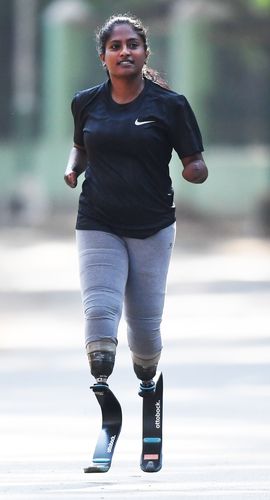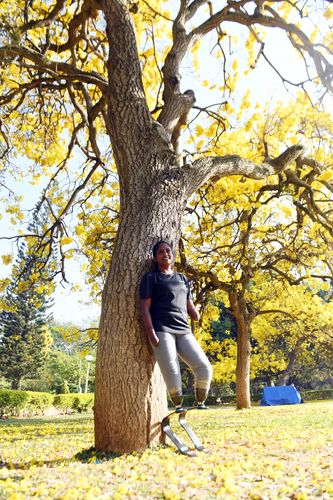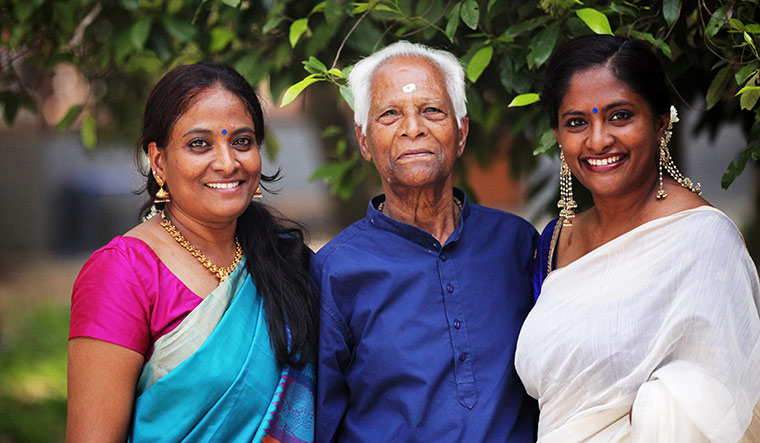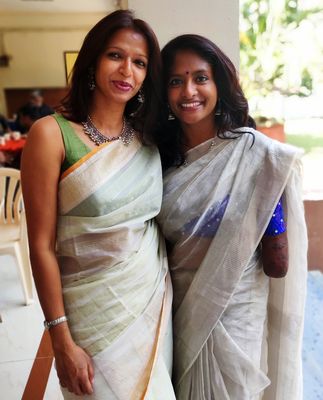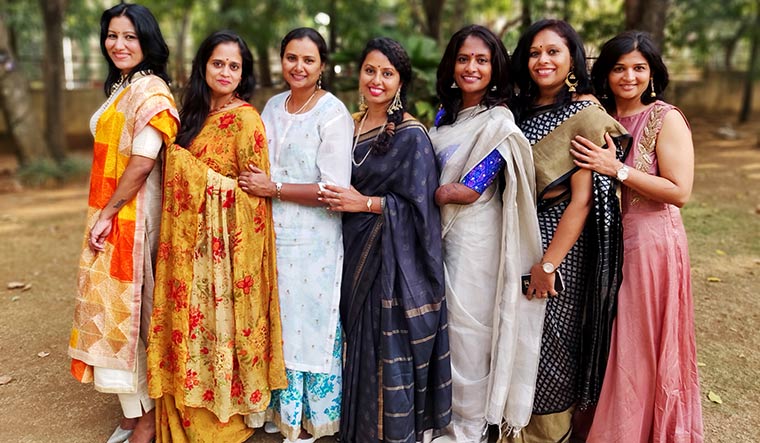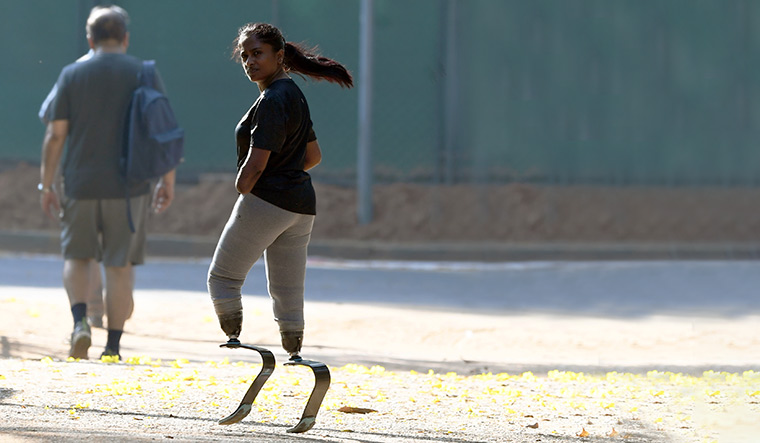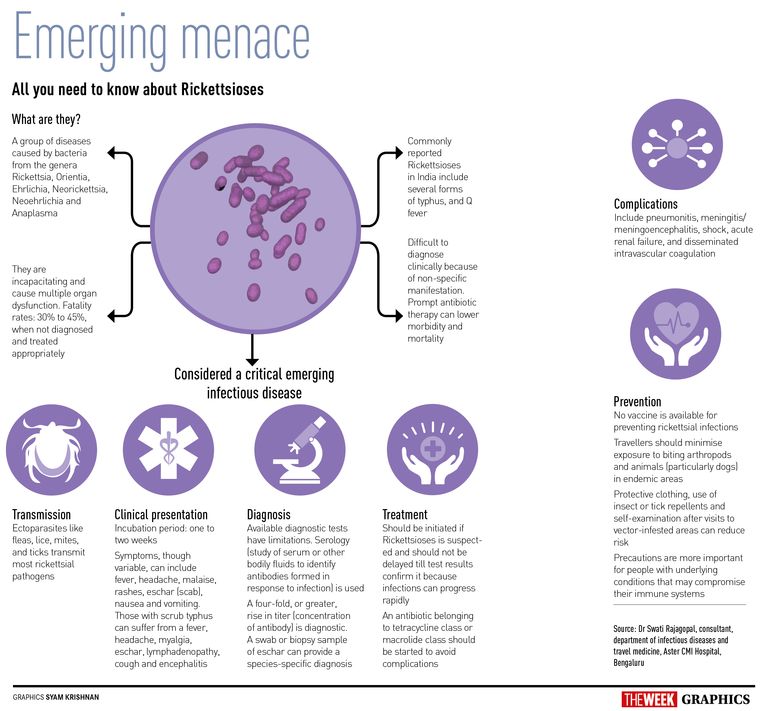Shalini Saraswathi lost her limbs to a rare bacterial infection she contracted while on a holiday in Cambodia in February 2012. "Around a month after the holiday, I started feeling exhausted and slightly feverish,” says Shalini, 39, wiping off her tears with the stub of her arm. "Since I was pregnant at that time, my doctor attributed these symptoms to the pregnancy. My condition deteriorated rapidly, however, and on April 1, 2012, I was admitted to the ICU of Bengaluru's Manipal Hospital. I had a multi-organ failure, my heart stopped beating and my lungs were filled with water. No one thought I would make it.”
She also lost the baby. Shalini recovered from her critical condition in a few days but the doctors were baffled about what had led to it. “Initially, I was treated for both malaria and dengue, as my platelet count had dropped substantially,” says Shalini. Then, the doctors discussed her case with infectious diseases specialists in Cambodia and concluded that she had contracted Rickettsial with morts, a bacterial infection that is rare in India, but endemic to Southeast Asia.
Shalini had blood clots on her hands and legs, which obstructed the blood flow through the circulatory system. Thus, she soon developed gangrene—a condition where body tissues die because of inadequate blood supply—in her legs. The doctors told Shalini that her legs would have to be amputated, but she was determined to save them and turned to alternative medicine.
A Malayali, raised in Bengaluru, Shalini had heard many stories of healing through ayurveda. Thus, she went to Ottapalam, in Kerala, and consulted the spiritual leader and ayurvedic practitioner Swami Nirmalananda Giri Maharaj. "With ayurvedic treatment, the gangrene went away, so we thought things would get better from there,” says Shalini. (The swami died in 2017.)
Back in Bengaluru, Shalini started working from home. “I was constantly typing on my laptop, and fractured my left hand in March 2013,” says Shalini, a deputy general manager at Firstsource Solutions, a business process outsourcing company. The doctors told her they had no choice but to amputate her hand. When she was admitted to hospital, Shalini still had hope that somehow the doctors would be able to save her hand. She remembers waking up dazed after the operation. “My hand was completely bandaged,” she says. “I asked a nurse if the doctors had managed to fix my hand. She looked extremely uncomfortable and said, 'They've cut it,' and quickly walked away.”
Then, in August 2013, while she was having a casual conversation with her brother-in-law, her right hand broke off like a piece of dried wood. “I soon realised there was no point in waiting for the inevitable, and in September 2013, I got both my legs amputated.” The effects of the surgery were excruciating, both physically and emotionally. “The stumps of my legs were swollen, and I was on painkillers," says Shalini. “Once the anaesthesia wore off, the pain was unbearable.”
When the pain subsided, and it dawned on her that she was completely immobile, the emotional trauma set in. It was a massive elephant in the room, as her family refused to discuss the subject in front of her. Every time she looked at the stubs of her limbs, she felt devastated.
As time went by, however, she began to accept her new reality. “I had pondered over the amputations for a year and a half before they took place,” she says. “If they had happened overnight, and I didn't have much of a say in the decision, it would have been more difficult to accept. By the time the amputations took place, I felt it was the right decision. There were various emotions in dealing with what had happened; I would sometimes feel hopeful and sometimes feel terrible. Somewhere along the line, however, I felt I would be okay, since I had been stuck in bed for so long, waiting for a miracle to happen. That was tiring. After the amputations, I felt like, 'It's done. Now I can move forward.' Looking back, I have no idea how I got through that time, or how I managed to sit at home for so long, doing nothing.”
Shalini was lucky to have a strong support system that helped her get back on track. Her friends and family played a huge role “in keeping her sane,” she says. She was administered antidepressants while in hospital, but didn't need them when she got home. Whenever she felt low, her mother would just let her cry; that made her feel better.
Sometimes, she wondered if she could have averted contracting Rickettsial with morts. “I might have contracted it by petting stray dogs,” she says. “An early diagnosis might have helped avert the amputations, though we don't know. The bacteria was in my system for a whole month [without being treated].”
Shalini is an extremely positive person, which greatly helped her recover emotionally. “There is never a dull moment when Shalini is around,” says her friend Anshu Reddy, 39, a fashion designer in Bengaluru. “You feel alive when you are with her. Even in adversities, we've found happiness. With her, I have learnt many of life's lessons and often seen its funny side. If I am a better person today, it's because she has played a huge role in my life. Few people can have that kind of an impact on one's life. That's what makes her one of a kind.”
After the amputations, ayurvedic treatments helped her heal. “Two months after the amputations, I began trying prosthetics, and in five months, I was back on my legs,” says Shalini, smiling.
Her husband, Prashant Chowdappa, who was with her in Cambodia, has been her rock. “What got us through that phase of our lives was her resilience and 'never give up' attitude,” says Prashant, 42. “I remember Shalu [Shalini] saying that we had hit rock bottom and that the worst was behind us. She is the emotionally stronger person in our relationship. There were times she would comfort the family, saying that whatever had happened was for the best. She's a 'glass half-full' kind of person.”
With great gusto, Shalini began tackling her problems one at a time. Being immobile, she had put on a lot of weight, so she started going to the gym. Most of the trainers were supportive, but were unsure of how to train a quadruple amputee. She was then introduced to B.P. Aiyappa, a coach at Bengaluru's Sri Kanteerava Stadium, who had worked with a person with similar disabilities.
"The intention was to just learn basic skills, like walking,” says Shalini. “Then, I really began to enjoy it. When you are not designed to do something, but manage to do it, it gives you a great sense of accomplishment. Somewhere along the line, I started thinking that if I could do this, I was going to be okay with my life.” Encouraged by Aiyappa, Shalini started running short distances.
A prosthetics company that was testing racing blades gave her a pair to try. “The blades have a lot of rubber inside, and make your legs perspire a lot,” says Shalini. “When you run, there is a tendency for them to slide, so you have to wipe them and put them back on. It's not as easy as it looks. You have to be fast, and there is a lot of technique involved.” Once she got used to them, she enjoyed running and sprinting with the blades. Her strength and stamina continuously increased and she was soon running up to 5km, then slowly built up to 10km.
In May 2016, much to the delight and admiration of her friends and family, Shalini participated in the TCS World 10K run in Bengaluru. “When I was able-bodied, I never ran,” says Shalini. “I did aerobics and other exercises, but not running. So running 10km was daunting, as it required a lot of endurance, but I managed to do it.”
Shalini is now an accomplished para-athlete. “Shalini has made us all proud,” says Aiyappa. “She won the bronze medal in the T44 category [a disability sport classification] for the 100 metres sprint at the 2018 National Para Athletic Championship. Currently, she is Asia No 3 in that category. She has been training hard for the 2020 Summer Paralympics.”
What does running mean to her? “For me, it has been about personal growth; I now feel I can deal with things that come my way and get through life,” she says. “Running has also given me the courage to chase my dreams, because you figure out you are strong enough to do it.”
Shalini has lost around 18kg in the past four years, and is thrilled that she can now wear what she likes. Before that, whenever she went shopping, she would get upset as the clothes she tried on were too tight. “Once, one of my friends got an outfit especially tailored for me, but it looked so terrible on me that I felt extremely unhappy about my body,” says Shalini.
The weight loss was gradual, and a healthy diet helped her achieve her goals. Pilates instructor and nutritionist Anisha Mankikar Naidu played an important role in her fitness journey. “Shalini is a foodie, yet can be extremely disciplined,” says Anisha. “She is on a high-protein, superfood-rich diet. I've planned her chart to ensure that she eats high-fibre, high-protein and micronutrient-rich meals, which include millets and good oils. She loves south Indian food, so gets to eat that too, by making a few smart changes.”
Shalini's workout was tailor-made to increase her stability and strength. “During the first year, we concentrated mainly on deep breathing and balance, hip flexor exercises, and lower-back strength and flexibility,” says Anisha. “Gradually, we began weight training with tie-up weights and TheraBands. Pilates and core strength exercises have helped increase her stability, strength and balance, [because of which she is] able to run with blades. It is critical for all runners to work on these aspects. For Shalini, running with blades can have a strong impact on her lower back. Core training and pilates have helped her achieve strong core musculature to withstand that impact. She is a dream student who never complains about tough workouts.”
Dipali Pandey, Shalini's physio and fitness coach, has a similar opinion. “Working with Shalini is just amazing,” says Dipali, founder of Peak Performance, a physical therapy and sports rehabilitation centre in Bengaluru. “I have worked with an amputee before, but never with a bilateral legs and hands amputee. Since she is a blade runner, her strength requirements are more than just for functionality; [she needs strength] for sports performance, and that is challenging.” Shalini trains with Dipali four times a week, which includes two sessions of strength and stability, one core workout and a speed session, and one session each for soft tissue release and back mobility. “All these lead to a fit and healthy lifestyle, and are pivotal for her sport,” says Dipali.
Shalini's days are busy. She reaches Sri Kanteerava Stadium at 6.30am and trains with Aiyappa until 9am. She then goes home to get ready for work. In the evenings, she trains with Dipali at Peak Performance. Between work, training and running, she finds time to spend with friends and family.
Shalini has become a popular motivational speaker and blogger, and her journey has positively impacted the lives of numerous people. “Knowing her for more than a decade has been the best thing that has happened to me,” says Praveen Singh, 40, a life coach. “She has made a huge impact on my life; I will forever be thankful for it. She is nothing less than a miracle in her own awesome way, and is the greatest example of how to live life in the best possible way. 'Live life on your own terms', 'Life is tough, but so are you': these are the life lessons she represents and inspires in every person she comes in contact with. The fighter's spirit she embodies makes her unique and special.”
Walking in Cubbon Park, one of her favourite spots in the city, Shalini admires the flowers and the changing seasons; she, herself, seems to represent a lone tree that has withstood the onslaught of a severe winter, only to bloom again in the spring.


